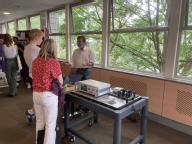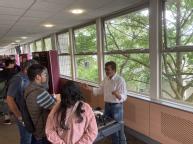Anis Rahman
My research is focused on using spins such as those of nitrogen-vacancy centres in diamond and ferro/ferrimagnets for developing new quantum technologies and studying fundamental physics. My research sits within the broader Warwick QuantumLink opens in a new window initiatives.
Grants
- A. T. M. Anishur Rahman (PI) and G. Morley (Co-I), "A new ultra-sensitive NV centre in diamond based magnetometer," EPSRC IAA 2022-25, £66,989, 2023-2024.
- G. Morley (PI) and A. T. M. Anishur Rahman (Co-I), "Magnetic flux concentrators to increase the sensitivity of diamond magnetometers for medical diagnosis," EPSRC IAA 2022-2025, £19,713, 2022.
- P. F. Barker (PI), A. T. M. Anishur Rahman (Co-I) and S. Bose (Co-I), "Laser refrigeration on the nanoscale: From nanocryostats to quantum optomechanics," EPSRC (EP/S000267/1), £729,667, 2018-2022.
Patents
A T M Anishur Rahman, "NVito: A solid-state atomic magnetometer," GB2312664, August 2023.
Publications
New article titled: Levitated magnetic particles as ac magnetic field sensorsLink opens in a new window (see also on Archive HAL for an earlier versionLink opens in a new window).
I also gave an invited talk on this new magnetometer in SPIE Photonics West. The associated paper can be found hereLink opens in a new window.
For my other publications see my Google Scholar page
Reviewer
I review URKI Grants. I am also review journals in my field including New Journal of Physics, Physical Review X, Nature Communications and others.
Student supervision
I currently supervise three PhD students as a second supervisor.
- Karishma Gokani
- Stuart Graham
- Alex Newman
Research Interests
Magnetometry
NV centres in diamond

We are developing a new nitrogen vacancy centre (NVC) in diamond based magnetometer. The sensitivity of such a magnetometer is predicted to be orders of magnitude better than the existing NVC based magnetometer. Reza Kashiban, a PDRA, is working on this project.
Levitated magnetic particle
Electromagnetic waves are widely used including in defense, biomedicine, and fundamental science. Their efficient detection determines how we communicate, defend against adversaries, diagnose diseases and perform search and rescue operations. In this article, exploiting the precession of a levitated magnetic particle in ultra-high vacuum, we show that weak electromagnetic waves down to the femtotesla level can be detected. It is also shown that such a sensor has a large dynamic range over a millitesla, is continuously tunable over many gigahertz and can detect frequencies with sub-hertz resolutions. The direction of arrival of the incoming electromagnetic wave can also be found relatively easily.
For further details see ( Archive HAL for an earlier versionLink opens in a new window).
Macroscopic spatial superposition
The superposition principle is one of the fundamental tenets of quantum mechanics. According to it, an object can be in multiple states at the same time. For example, it can be up and down at the same time. While this is weird, over the years many experiments have confirmed this. The heaviest object so far put into such a state weighs about 10-23 kgLink opens in a new window. I am currently working on a project which aims to put a diamond containing a single NVC into a spatial superpositionLink opens in a new window e.g. left and right at the same time. The mass of such a object will be about 10-17 kg. In other words, it will be about 6 orders of magnitude heavier than the current record. The spatial separation between the left and the right position i.e. the size of the superposition will be less than a picometer 10-12 m) or less than a trillionth of a meter. In contrast, the size of the diamond is approximately a millionth of a meter. While the size of the superposition will be small, the overall experiment will be record breaking.
In a separate proposal, I have proposed a theoretical scheme which can create a large spatial superposition. In this proposed scheme, I use a levitated magnetic particle which contains many coherently coupled spins. In a small nanomagnet, all spins are strongly coupled with each other via the exchange coupling and they behave as a single entity. The magnetic moment (m) of such a tiny magnet can switch between north and south. At high temperature this is called superparamagnetism while at low temperature (< 1 K) where the thermal fluctuations are not viable (not enough thermal energy left), quantum fluctuations (roughly speaking) appear. This quantum fluctuation is known as tunneling. From quantum mechanics we know that when tunneling is allowed,a superposition of the states emerges. In this case, a superposition of the north and the south pole $(\vert N\rangle+\vert S\rangle)/\sqrt{2}$. In the scheme that I have proposed, I use this north- south spin superposition in combination with a magnetic field gradient for the creation of a spatial superposition or a Schrodinger cat. For a 20 nm magnetic particle, the spatial superposition can be up to 2 micrometers- significantly larger than the object itself. More details can be found in the article titled "Large spatial Schrödinger cat state using a levitated ferrimagnetic nanoparticleLink opens in a new window"
Dark matter search
Our universe consists of 5% normal matter which includes all the objects that we can see e.g. planets, stars, galaxies etc, 27% dark matter (does not interact with light hence dark) and 68% dark energy. Dark energy is believed to be responsible for the expansion of our universe while dark matter is considered to be behind the large scale astronomical structures e.g. galaxies. Dark matter can be hot, warm and cold. As per our current understanding hot dark matter is not detectable. Axion, a hypothetical particle, is considered to be one of the main constituents of cold dark matter. Its mass is predicted to between 10-7 μeV and 104 μeV. I have recently proposed a scheme which can search axions between 500 μeV and 5000 μeV. In this scheme, I use a magnetic rod placed inside a high finesse optical cavity. The optical cavity can be formed by using two mirrors or by coating the ends of the magnets with appropriate mirror coatings. A probe laser propagates through the long axis of the magnetic rod while the magnetization of the magnet is in the perpendicular direction of the light field propagation direction. More details can be found in the paper titled "Ultrawideband axion search using a Faraday haloscope"Link opens in a new window.
Departmental Responsibility
Warwick Open Day
I help colleagues who organize the University of Warwick Open Days. As a part of this activity, I demonstrate different experiments to the perspective students and their parents. Below are some photographs which were taken when I was demonstrating our photon entanglement experiments to the visitors.




Outreach
Research Culture
I have recently participated in a research culture projectLink opens in a new window and it was real fun.
School talks
To raise awareness about the STEM subjects, the counter intuitive predictions of quantum mechanics and its conflict with STEM subjects, I give talks at local high schools in Coventry titled "Physics of the universe: Einstein vs Schrodinger". In this talk, I give a very general overview of the fundamental laws of physics. I also try to highlight the incompatibility between quantum mechanics and general relativity (GR) and the present push for developing a unified theory. I also show different experiments that I am currently doing at Warwick. Some photographs from these talks are shown below
Sydney Stringer Academy, Hillfield, Coventry



Finham Park School, Finham, Coventry


Article in ScienceX Dialog
I wrote a news article on spatial superpositions Link opens in a new windowfor ScienceX Dialog run by Phys.Org. This is based on my theoretical article on how to create large spatial superpositionsLink opens in a new window or Schrodinger cats using spin tunneling magnetic particles. In this article, I portray the idea of spatial superposition by showing a child lives in New York and London at the same time (see photograph below).

